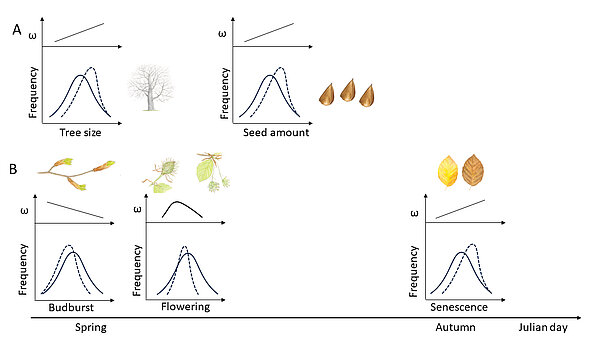Low but significant evolutionary potential for growth, phenology and reproduction traits in European beech

Local survival of forest tree populations under climate change depends on existing genetic variation and their adaptability to changing environments. Responses to selection were studied in European beech (Fagus sylvatica) under field conditions. A total of 1087 adult trees, seeds, 1-year-old seedlings and established multiyear saplings were genotyped with 16 nuSSRs. The study was recentrly published in Molecular Ecology.
Adult trees were assessed for phenotypic traits related to growth, phenology and reproduction. Parentage and paternity analyses were used to estimate effective female and male fecundity as a proxy of fitness and showed that few parents contributed to successful regeneration. Selection gradients were estimated from the relationship between traits and fecundity, while heritability and evolvability were estimated using mixed models and the breeder's equation.
Larger trees bearing more fruit and early male flowering had higher total fecundity, while trees with longer growth season had lower total fecundity (directional selection). Stabilizing selection on spring phenology was found for female fecundity, highlighting the role of late frosts as a selection driver. Selection gradients for other traits varied between measurement years and the offspring cohort used to estimate parental fecundity.
Compared to other studies in natural populations, it has been found low to moderate heritability and evolvability for most traits. Response to selection was higher for growth than for budburst, leaf senescence or reproduction traits, reflecting more consistent selection gradients across years and sex functions, and higher phenotypic variability in the population. The study provides empirical evidence suggesting that populations of long-lived organisms such as forest trees can adapt locally, even at short-time scales.
Authors: Marjana Westergren, Juliette Archambeau, Marko Bajc, Rok Damjanić, Adélaïde Theraroz, Hojka Kraigher, Sylvie Oddou-Muratorio, Santiago C. González-Martínez